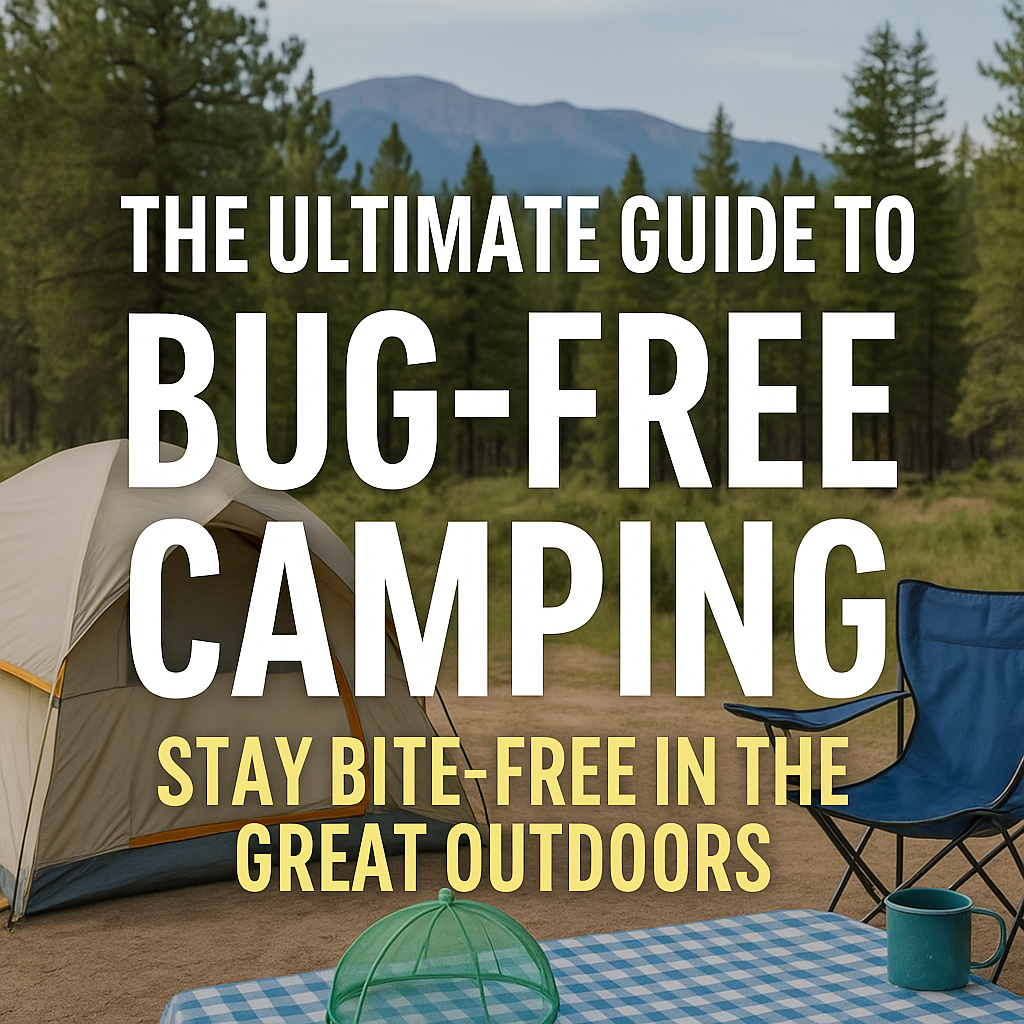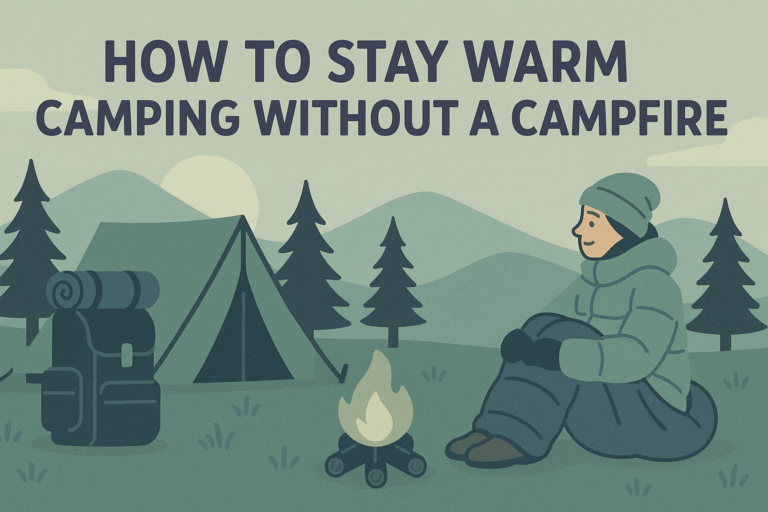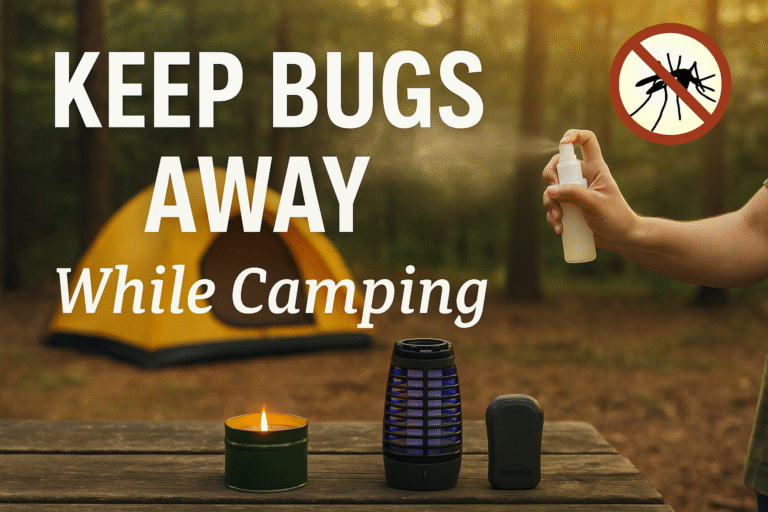
Few things ruin a camping trip faster than bug bites. Whether it’s buzzing mosquitoes, sneaky ticks, or persistent flies, insects can turn a peaceful getaway into an itchy nightmare. This ultimate guide to bug-free camping walks you through how to prepare, what gear to pack, and what techniques actually work — whether you’re heading into the woods, mountains, or your own backyard.
This is the central resource in our Bug-Free Camping Series. For specific tips, check out:
- How to Keep Bugs Away While Camping
- Staying Warm Without a Campfire (includes tent sealing tips)
🧠 What Attracts Bugs to Campsites?
If you've ever wondered why bugs seem to crash your camping trip, you're not alone. Bugs are drawn to campsites for several reasons, and knowing what attracts them can help you take steps to keep them away. Whether it's mosquitoes, flies, ants, or bees, these tiny invaders are surprisingly good at finding you. Here are the main culprits:
- Body heat and sweat: Insects like mosquitoes are experts at detecting body heat and the lactic acid in sweat. After a long hike or a warm afternoon by the campfire, your body becomes a beacon for bugs.
- CO₂ from breathing: Every time you exhale, you release carbon dioxide. Mosquitoes and other biting insects are especially sensitive to CO₂ and use it to locate their next meal — you.
- Food smells and trash: The aroma of sizzling bacon or sweet snacks can draw in more than just fellow campers. Ants, bees, flies, and even wasps are quick to investigate any unsealed food or garbage left out in the open.
- Standing water: Puddles, buckets, and even bottle caps can hold enough water to become a breeding ground for mosquitoes. Always empty unused containers and tip over anything that collects rainwater.
- Fragranced soaps and lotions: While you may love that fresh scent of coconut or lavender, bugs do too. Floral or fruity fragrances can attract mosquitoes and bees, so opt for unscented personal care products when you're in the wild.
By understanding these triggers, you can make simple adjustments to reduce your campsite’s bug appeal — like using scent-free toiletries, storing food properly, and eliminating standing water. A little awareness goes a long way in making your next outdoor adventure more comfortable and bite-free.
🛠️ Best Bug-Repelling Gear for Campers
The right gear makes a massive difference in bug protection. Here are our top-rated picks:
- Thermacell MR450 Repeller – Creates a 15-ft scent-free barrier against mosquitoes.
- Sawyer Picaridin Lotion – DEET alternative with 12-hour protection against ticks and mosquitoes.
- Coghlan’s Mosquito Net – A lightweight net for sleeping or hammock use.
- OFF! Deep Woods Towelettes – Portable, clean, and convenient bug repellent for on-the-go use.
🧴 Bug Spray vs. Natural Repellents
Both chemical and natural repellents can work — but they have different strengths. Here’s what to know:
Chemical Options
Chemical repellents are a popular and effective way to keep bugs at bay, especially in areas where insect-borne illnesses are a concern. Here are the most common choices:
- DEET: One of the most effective and widely used insect repellents for decades. DEET works well against mosquitoes, ticks, and other biting insects, but some users may find it greasy or irritating to sensitive skin. Use products with 20–30% DEET for optimal balance between protection and skin comfort.
- Picaridin: A newer alternative to DEET, picaridin offers long-lasting protection with a lighter feel. It’s odorless, non-greasy, and safe on plastics and outdoor gear — making it an ideal choice for campers who don’t want to damage synthetic fabrics or lenses.
- Permethrin: Unlike DEET or picaridin, permethrin is not applied to your skin. Instead, it’s used to treat clothing, hats, tents, and gear. Once dry, it bonds to fabric and repels (or even kills) insects on contact. Just make sure to let it dry completely before use, and never spray it directly on your skin.
Natural Options
Prefer a more eco-friendly or skin-sensitive solution? Natural repellents can be surprisingly effective, especially when used in combination. Just keep in mind they often need to be reapplied more frequently than chemical versions.
- Lemon eucalyptus oil: One of the few plant-based ingredients approved by the EPA for repelling mosquitoes. It offers similar protection to low-concentration DEET for up to six hours and is great for those looking to avoid synthetic chemicals.
- Citronella, lavender, and peppermint oils: These essential oils can help repel mosquitoes and flies, especially when used in diffusers or candles around camp. They're best for short-term relief or low-risk areas, and many people enjoy their pleasant scents.
- DIY spray: Mix witch hazel, distilled water, and a few drops of essential oils (like lemon eucalyptus or citronella) in a small spray bottle. This can be a fun, homemade solution for day hikes or evenings by the fire, though it will need to be reapplied often.
🧢 Bug-Blocking Clothing Tips
Your outfit is your first line of defense against biting insects, especially ticks and mosquitoes. With the right clothing, you can significantly reduce your exposure to bites — no spray required.
- Wear long sleeves and pants: Choose lightweight, breathable fabrics in light colors, which are less attractive to mosquitoes and help you stay cool under the sun.
- Use permethrin-treated clothing: Shirts, pants, hats, and even socks can be pre-treated with permethrin or sprayed at home for extra protection. These garments can stay effective through several washes.
- Tuck pants into socks or boots: This might look a little dorky, but it’s an effective tactic against ticks, which often latch onto ankles and crawl upward. Perfect for hikes in wooded or grassy areas.
- Wear a hat and neck gaiter: Covering your neck, ears, and scalp can prevent bugs from attacking these vulnerable areas, especially when you're near still water or dense brush.
🏕️ Camp Setup Tips That Keep Bugs Out
Where and how you set up your campsite plays a major role in how buggy your experience will be. The right location combined with smart layout choices can drastically reduce encounters with mosquitoes, ticks, flies, and gnats. These campsite setup tips will help you minimize pest problems from the start:
- Choose higher, breezy ground: Insects prefer calm, humid environments. Pitch your tent on slightly elevated terrain where wind helps naturally deter flying bugs like mosquitoes and gnats.
- Avoid areas with standing water or dense vegetation: Mosquitoes lay eggs in stagnant water, and tall grass or overgrown shrubs can harbor ticks. Look for clear, open areas at least 100 feet from water sources.
- Use a screen tent or mesh vestibule around eating areas: Creating a bug barrier while you cook or eat is essential. Mesh tents or pop-up screen shelters keep flying insects out without the need for chemicals.
- Seal up food and trash immediately after meals: Food smells are a top attraction for insects like ants, flies, and yellowjackets. Store leftovers in airtight containers and double-bag trash to minimize scent trails.
- Keep tent doors zipped shut at all times: Even one unzipped flap can invite a swarm of bugs inside. Make it a rule for everyone to close the tent promptly — even if it’s “just for a second.”
Pro Tip: Setting up camp earlier in the day gives you time to inspect the area for insect hot spots and adjust before the evening mosquito rush.
✅ Bug-Free Camping Checklist
If you're serious about keeping your campsite bug-free, preparation is key. Use this printable or packable checklist to make sure you’re fully geared up with the best bug-repelling tools and essentials. It combines both chemical and natural options for a well-rounded approach.
- DEET or Picaridin-based repellent: Essential for high-risk mosquito zones and proven to provide hours of protection.
- Thermacell or electronic repeller: Creates a scent-free zone of protection ideal for picnic tables, hammocks, and outdoor seating.
- Natural oil spray or DIY version: Great for skin-sensitive campers and eco-conscious setups. Best used alongside other repellents.
- Mosquito net or screen tent: Provides a physical barrier when sleeping, eating, or relaxing. A must-have in humid or forested regions.
- Permethrin-treated clothes or spray: Wearables that repel ticks and mosquitoes on contact. Ideal for hiking, fishing, and dawn/dusk activity.
- Trash bags and sealed containers: Prevent bug infestations by locking in scents and limiting access to food and waste.
- Citronella candles or coils (outdoor only): Best for short-term area protection while dining or relaxing around camp — always use with care and supervision.
By combining multiple methods from this checklist, you’re not just reducing bug bites — you're enhancing your camping comfort and safety. Always customize your packing list based on location, weather, and local insect risks.
🙋♀️ FAQ: Bug-Free Camping Tips
Do Thermacells actually work?
Yes! Thermacell units are one of the most effective chemical-free tools against mosquitoes. They work best in still air and can protect your entire picnic table or tent area.
Can you camp bug-free without chemicals?
Mostly — but not always. You can reduce exposure with smart clothing, screens, and natural oils, but in high-infestation zones, stronger repellents may still be needed.
What’s the best time of year to avoid bugs?
Late fall and early spring tend to be more bug-free. Mid-summer and rainy seasons are peak insect times, especially in wooded or swampy areas.
🌲 Final Thoughts: Camp Without the Itch
Getting outside shouldn’t mean getting eaten alive. With a mix of smart prep, reliable gear, and natural tricks, you can enjoy your trip — and wake up bite-free. Be sure to explore the rest of our Bug-Free Camping Series for focused tips on gear, clothing, and campsite strategy.






